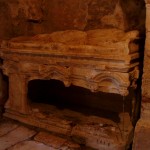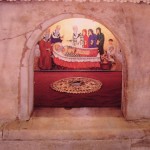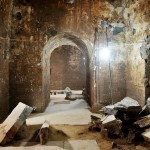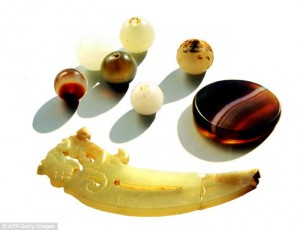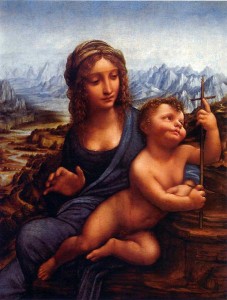 Here’s a stolen Holy Mother and Child with a happy ending, for a change. Leonardo da Vinci’s Madonna of the Yarnwinder was stolen from the walls of Drumlanrig Castle on August 23, 2003. Four men joined a tour group visiting the castle, then lagged behind the rest of the ground and overpowered the security guard who was guarding the painting. They hustled it into a waiting car and got away, discarding the frame just outside the castle walls.
Here’s a stolen Holy Mother and Child with a happy ending, for a change. Leonardo da Vinci’s Madonna of the Yarnwinder was stolen from the walls of Drumlanrig Castle on August 23, 2003. Four men joined a tour group visiting the castle, then lagged behind the rest of the ground and overpowered the security guard who was guarding the painting. They hustled it into a waiting car and got away, discarding the frame just outside the castle walls.
It is one of the few Leonardos in private hands and the only Leonardo in Scotland. The 9th Duke of Buccleuch took it with him wherever he went. Needless to say, he was devastated by the theft. The painting had been in his family for generations.
Then, out of the blue, 4 years later the painting turned up in a Glasgow law office. Unfortunately, the 9th Duke died just a few weeks before the Madonna was found. 🙁
Valued in the region of £50 million, the work, owned by the Buccleuch Heritage Trust, was considered so important that it was placed on the FBI’s list of the world’s ten most wanted stolen artworks.
“One very much hoped we would see it again,” said [director Michael] Clarke. “Very often these great works do come back — though not always, sadly — and they are recovered often through clever police work. I know it was extremely upsetting for the previous Duke of Buccleuch. I know he was really, really knocked back by this theft. It is a pity the recovery did not come in time for him to enjoy it.”
Michael Clarke is the person who authenticated the work after the police found it. He had been there in 1992 when the 9th Duke had loaned it to the National Gallery for display, so he knew right away it was the real deal.
The 10th Duke asked the conservators of the National Gallery to cared for it after it was returned. They carefully examined it for damage — there was none, thankfully — and reframed it. Now the 10th Duke has now lent it to the National Gallery of Scotland in Edinburgh, where it takes pride of place in the Old Masters gallery.
From a letter by a contemporary of Leonardo’s, we know he was painting it for Florimond Robertet, a French diplomat. Leonardo was less than reliable at completing his commissions, however, so we don’t know if Robertet ever got the painting.
We also don’t know how much of it was painted by the master’s hand. His studio filled in a lot of blanks when he got behind on his delivery dates. In this case, the overall design, the figures and the rocks in the foreground all appear to be Leonardo’s. The background was likely added, possibly quite a bit later, by another artist or artists.
Eight men have been with the theft. They are scheduled to go on stand trial next year. Apparently they didn’t even know its real value. They were just using it as collateral for drug deals, the bastards.
